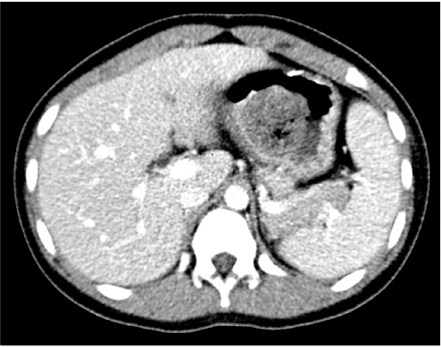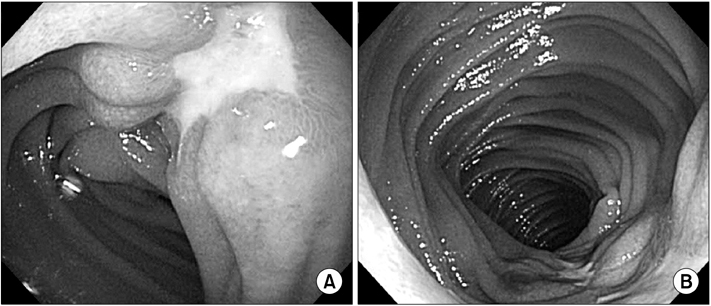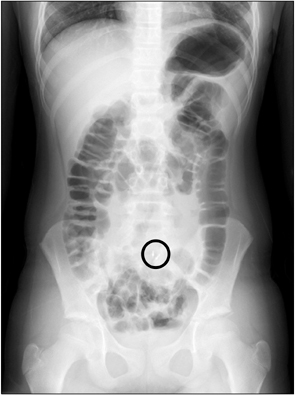Pediatr Gastroenterol Hepatol Nutr.
2012 Dec;15(4):266-271.
A Case of Small Bowel Ulcer Associated with Helicobacter pylori
- Affiliations
-
- 1Department of Pediatrics, Kangnam Sacred Heart Hospital, Hallym University College of Medicine, Seoul, Korea. izzih@medimail.co.kr
- 2Department of Internal Medicine, Kangnam Sacred Heart Hospital, Hallym University College of Medicine, Seoul, Korea.
Abstract
- The etiology of peptic ulcer disease in children may be primary, associated with Helicobacter pylori infection, or secondary, relied on underlying disease. Ulcerative lesions by H. pylori are mainly distributed in the duodenal bulb and they are rare below the ampulla of Vater because H. pylori growth is inhibited by bile juice. In this reason, there are only some restrictive reports presented small bowel ulcer associated H. pylori. We found multiple small bowel ulcerative lesions associated with H. pylori in an 11-year-old girl without any systemic disease while performing esophagogastroenteroscopy to the level of the proximal jejunum for differentiating bezoar. The abdominal pain improved after the patient was administered H. pylori eradication therapy. Because a small bowel ulcer associated with H. pylori has rarely been reported, we report it here with literature review.
Keyword
MeSH Terms
Figure
Reference
-
1. Dohil R, Hassall E. Wyllie R, Hyams JS, editors. Gastritis, gastropathy and ulcer disease. Pediatric gastrointestinal and liver disease. 2006. 3rd ed. Philadelphia: Elsevier Saunders;392–407.
Article2. Drumm B, Day AS, Gold B, Gottrand F, Kato S, Kawakami E, et al. European Society for Paediatric Gastroenterology, Hepatology and Nutrition. Helicobacter pylori and peptic ulcer: Working Group Report of the Second World Congress of Pediatric Gastroenterology, Hepatology, and Nutrition. J Pediatr Gastroenterol Nutr. 2004. 39:Suppl 2. S626–S631.3. Macarthur C, Saunders N, Feldman W. Helicobacter pylori, gastroduodenal disease, and recurrent abdominal pain in children. JAMA. 1995. 273:729–734.
Article4. Seo JK. Helicobacter pylori infection in children. Korean J Pediatr Gastroenterol Nutr. 1998. 1:9–18.5. Seo JK. Recurrent abdominal pain in children. J Korean Med Assoc. 1999. 42:859–867.6. Yeomans ND. The ulcer sleuths: the search for the cause of peptic ulcers. J Gastroenterol Hepatol. 2011. 26:Suppl 1. 35–41.
Article7. Nayeb-Hashemi H, Kaunitz JD. Gastroduodenal mucosal defense. Curr Opin Gastroenterol. 2009. 25:537–543.
Article8. Graham DY, Osato MS. H. pylori in the pathogenesis of duodenal ulcer: interaction between duodenal acid load, bile, and H. pylori. Am J Gastroenterol. 2000. 95:87–91.
Article9. Warren JR, Marshall B. Unidentified curved bacilli on gastric epithelium in active chronic gastritis. Lancet. 1983. 321:1273–1275.
Article10. Queiroz DM, Rocha GA, Mendes EN, Carvalho AS, Barbosa AJ, Oliveira CA, et al. Differences in distribution and severity of Helicobacter pylori gastritis in children and adults with duodenal ulcer disease. J Pediatr Gastroenterol Nutr. 1991. 12:178–181.
Article11. Bittencourt PF, Rocha GA, Penna FJ, Queiroz DM. Gastroduodenal peptic ulcer and Helicobacter pylori infection in children and adolescents. J Pediatr (Rio J). 2006. 82:325–334.12. Hobsley M, Tovey FI, Holton J. Precise role of H. pylori in duodenal ulceration. World J Gastroenterol. 2006. 12:6413–6419.13. Skok P. An unusual clinical course of a hormone-secreting gastrointestinal tumor: a case presentation from clinical practice. Hepatogastroenterology. 1998. 45:1655–1659.14. Clémençon GH, Lawson HH. Enhancement of duodenal and jejunal ulceration by histamine-induced gastric hypersecretion in dogs with diversion of duodenal contents. Scand J Gastroenterol Suppl. 1984. 92:129–132.15. Mizukami K, Murakami K, Abe T, Inoue K, Uchida M, Okimoto T, et al. Aspirin-induced small bowel injuries and the preventive effect of rebamipide. World J Gastroenterol. 2011. 17:5117–5122.
Article
- Full Text Links
- Actions
-
Cited
- CITED
-
- Close
- Share
- Similar articles
-
- A Case of Resolution of Duodenal Obstruction Caused by Duodenal Ulcer after the Eradication of Helicobacter pylori Infection
- Difference in Helicobacter pylori Eradication between Patients with Iatrogenic Ulcer after Endoscopic Resection and Patients with Peptic Ulcer
- Prevalence of Helicobacter pylori infection in patients of peptic ulcer among Korean people
- The Effect of Helicobacter pylori Infection on Peptic Ulcer Bleeding
- Helicobacter pylori-negative Peptic Ulcer





